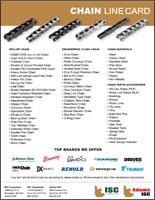 Chain
Chain
ISC Companies and affiliate Adams-ISC are distributors of mechanical power transmission parts including chain. For more information about the brands we offer and/or pricing, please contact us by phone 763-559-0033, by email [email protected], or by filling out our online contact form.
Chain drives for industrial applications transmit power from one sprocket to another via a chain. They are available for a wide variety of speeds, torque, and operating conditions. Chains reduce speed and increase torque from an input shaft to an output shaft, and some are used as conveyors. Other characteristics include self-lubrication, corrosion resistance, and lightweight material options.
Teeth on the the driving sprocket engage the chain, applying a tensile load that pulls the chain links and powers the driven sprocket. Only a few sprocket teeth are required for effective engagement, allowing for higher speed ratios than belt drives.
A wide variety of standard and non-standard chain and sprocket designs are available. The ASME (American Society of Mechanical Engineers) publishes standards, prefix ASME B29.
Advantages
- Versatility: cut-to-length
- Variety: many attachment styles, spacing, and materials
- Flexibility: can bend back over sprockets while maintaining engagement and avoiding slippage
- Durability: long operating life
- Operates in hostile environments
- Unlimited shelf life: will not deteriorate if stored correctly
- Can be repaired or replaced without disturbing equipment
- Can be sized to handle large HP loads and speeds
Disadvantages
- May have higher operating noise levels (low noise and silent options available)
- Will wear and potentially elongate over time
- Slightly lower speed limitation than belt and gear drives
- Need to replace sprockets because of wear when worn chain is replaced (unlike V-belt sheaves that are low wear)
 Content on this page was created using excerpts from the Power Transmission Handbook (5th Edition), which is written and sold by the Power Transmission Distributor’s Association (PTDA).
Content on this page was created using excerpts from the Power Transmission Handbook (5th Edition), which is written and sold by the Power Transmission Distributor’s Association (PTDA).

















You must be logged in to post a comment.